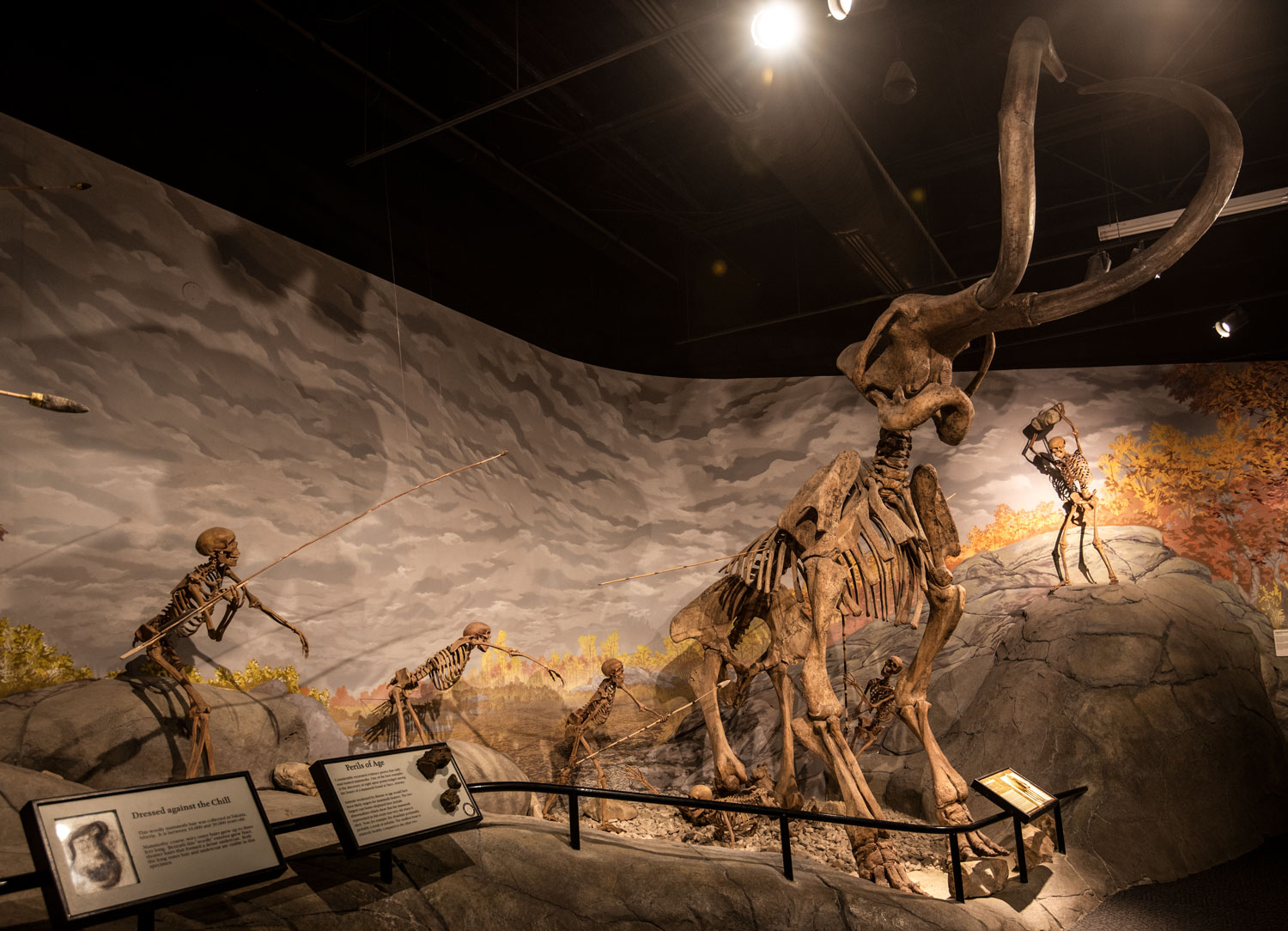Going On A Mammoth Hunt
Photos by Forrest Anderson
Woolly mammoths have never been so popular. The lumbering creatures of both the real Ice Age and the Ice Age films have captured the public imagination in a recent series of dramatic news stories about their possible revival.
In addition, mammoths have become top celebrities at museums and research conferences as scientists discover more about their herds which once roamed North America, Asia and Europe and the ancient humans that interacted with them.
What were mammoths and why would we want to bring them back?
Mammoths are extinct trunked mammals of the elephantid genus Mammuthus. They had long, curved tusks and the woolly variety had hair up to three feet long with a shorter undercoating of hair that kept them warm in frozen northern climates during the Ice Age. They were like elephants with coats, except that some were larger than elephants. They are related to modern elephants, most closely to Asian ones.
Mammoths lived between 5 million and 4,000 years ago, so unlike dinosaurs, they overlapped with humans who hunted them and used their bones and tusks to make huts and tools. Mammoth tusks are still harvested for ivory carving.
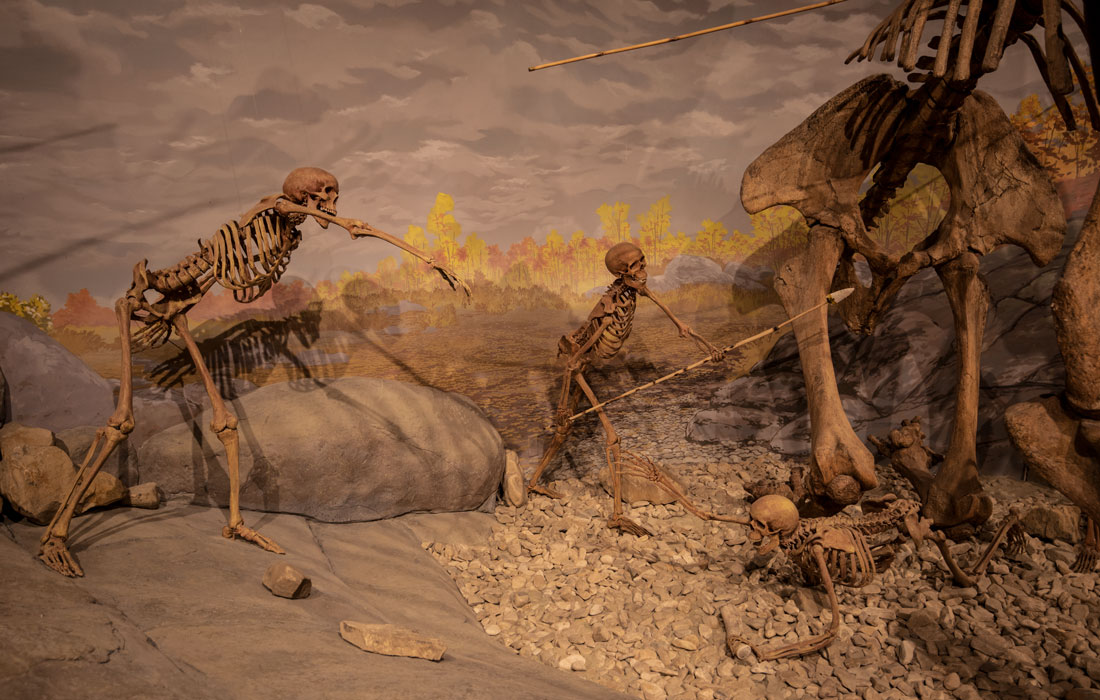
The woolly mammoth, the cuddly giant depicted as Manny in the Ice Age films, is just one species of mammoths that are all believed to have descended from mammoths that appeared about 5 million years ago in southern and eastern Africa. These early mammoths’ descendants moved north about 3 million years ago, diverging into new species that roamed over most of Eurasia and developed into the steppe mammoth. The woolly mammoth appeared between 800,000 and 400,000 years ago in Siberia and replaced the steppe mammoth in Europe about 200,000 years ago.
Mammoths migrated into America at least 600,000 years ago, but possibly much earlier, when low sea levels during an ice age created a temporary land bridge across the Bering Strait. Mammoth bones have been found in a number of places in America. Columbian mammoths and woolly mammoths apparently interbred in North America to produce a hybrid.
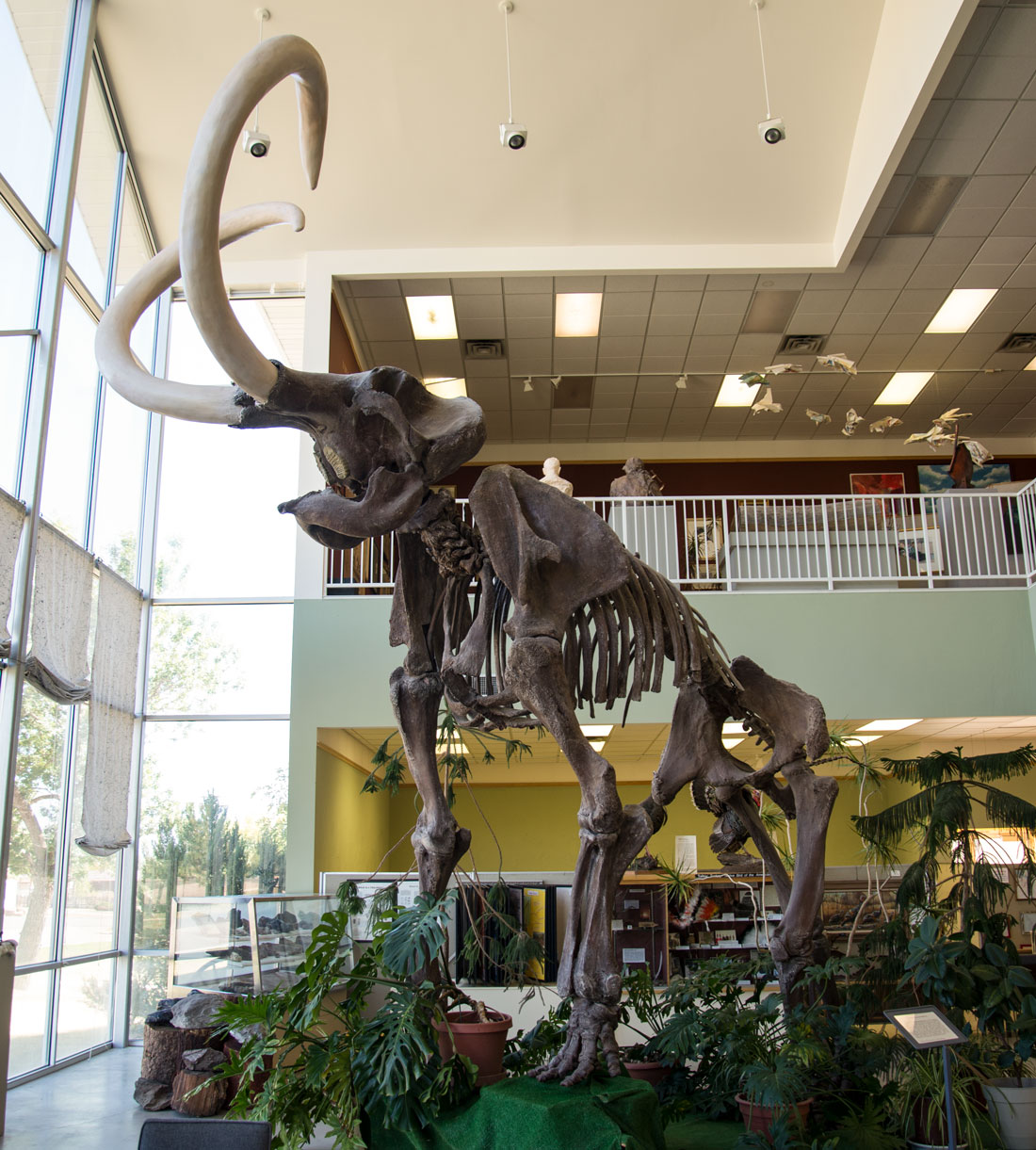
Replica of a Columbian mammoth discovered in 1988 in the Manti La Sal National Forest in Utah. It was 15 feet tall and about 60 years old when he died between 11,500 and 9,500 years ago. The mammoth became trapped in a muddy bog and died soon after. Its bones were preserved in icy mud. The original bones, which are not fossilized, are stored in a special storage area to preserve them.
When the Great Pyramid of Egypt was being built 3,700-4,000 years ago, a dwarf variety of the last woolly mammoths were still alive on modern Russia’s Wrangel Island in the Arctic Ocean. They became extinct just before 1700 B.C. Bones of another dwarf variety about four-six feet tall have been found on California’s Channel Islands and a smaller variety has been found on Crete.
The different species of mammoths are believed to have developed because of changes in environment, climate, diet and migration over time.
Woolly mammoths, the variety that scientists hope to bring back, were admirably adapted to the cold weather of the northern steppe on which they roamed. They were about the size of the Asian elephant – 10 feet tall and with a weight of six tons.
Wooly mammoths had, as Sid the sloth pointed out in Ice Age, “fat hair.” More precisely, they had fat – about four inches under their skin for insulation – and two layers of hair. Scientists who studied the remains of a mammoth calf found that fat enabled it to store large amounts of nutrients needed for survival in temperatures down to -58 F. The fat also allowed the mammoths to increase their muscle mass and fight enemies.
Mammoth ears and tail were about a sixth as long as those of a modern elephant, so they did not get frostbite.
In 2010, scientists discovered that woolly mammoth blood had anti-freeze capabilities. They sequenced hemoglobin genes from the DNA of three Siberian mammoths who were tens of thousands of years old and had been preserved in permafrost. The DNA sequences were converted into RNA and inserted into E. coli bacteria, where the bacteria manufactured mammoth protein. The result was like going back into time and taking a blood sample from a living mammoth. The scientists then tested the proteins and found that three changes in the hemoglobin sequence allowed mammoth blood to deliver oxygen to cells even at very low temperatures.
Scientists theorize that mammoths’ 15-feet-long tusks were used for pushing away ice and snow and defending themselves. Much of what is known about mammoths is from their tusks and teeth. Scientists can tell a specimen’s age, health and what it ate from rings on tusks. They know from tusks and teeth that mammoth young were nursed for at least three and perhaps up to five years, much longer than modern elephants. Baby tusks appeared when a mammoth was six months old and were replaced by a permanent set at age 18 months. The tusks thereafter grew about 1-6 inches a year. As time went on, mammoth species developed more and more ridges on their teeth, which can therefore be used as a way to determine when particular species appeared.
Mammoths, like modern elephants, probably had a gestation period of 22 months, and gave birth to a single calf.
Woolly mammoths were herbivores, eating mostly grasses but also leaves, fruits, berries, nuts and twigs. Based on what elephants eat – between 130 to 660 pounds of food per day - mammoths were prodigious eaters. Elephants produce between 310 and 400 pounds of dung per day and mammoths are believed to produced at least as much, so they were fantastic fertilizers of grasslands.
All of these characteristics make the mammoth an attractive candidate for de-extinction. Cloning mammoths from frozen remains is an impossibility because the DNA that scientists have extracted from woolly mammoths that were frozen in permafrost is far too fragmented and degraded to clone. However, there is another route.
In February 2021, scientists reported for the first time the sequencing of DNA from animal remains that were over a million years old - a mammoth. This is the oldest DNA that has been sequenced.
Ninety-nine percent of the elephant genome matches that of the mammoth genome, so it may be possible to engineer a modern elephant with the external appearance and traits of a mammoth that would enable it to survive in the cold north. The result would be an elephant-mammoth hybrid with about 1 percent distinctively mammoth genes. From there, more mammoth genes could be gradually added to the hybrid offspring.
A new bioscience and genetics company called Colossal has raised $15 million to do that, teaming up with geneticists led by George Church of Harvard Medical School.
The project has several stages:
Engineering the genes. Church has been at the cutting edge of genomics, including the use of CRISPR, the revolutionary gene editing tool that can alter the characteristics of living species. His work creating pigs whose organs are compatible with the human body means a kidney for a patient in need of a transplant might one day come from a swine. This week, scientists announced that they temporarily attached a pig kidney that had been genetically modified to prevent rejection to a brain-dead patient and it had worked normally. The patient had wanted to donate her organs but they were unsuitable for donation, so her family agreed to the experiment after she died. The experiment is an important step in the quest to develop suitable pig organs for human transplant to ease the human organ shortage.
Church’s team is using CRISPR gene-editing technology that enables scientists to alter a creature’s genetic materials by cutting targeted strands of DNA and adding or deleting genetic materials to change the overall DNA sequence. The team is splicing the DNA of woolly mammoths with that of Asian elephants to create a breed of hybrid mammoth-elephants that are cold- and virus-resistant. They also will be poacher-resistant because Church has genetically modified their tusks to be short and thus unprofitable for mammoth ivory hunters. Church estimates his team is about 40 genetic adjustments away from engineering a cell that can be used to create the embryo of the new woolly mammoth.
The team has analyzed the genomes of 23 elephant species and extinct mammoths, Church said. There are 60 genes that experiments suggest are important to the distinctive traits of mammoths, such as hair, fat, small ears and a high-domed skull.
Creating a mammoth embryo. The scientists will try to make an elephant embryo with its genome modified to resemble an ancient mammoth by removing DNA from an elephant egg and replacing it with mammoth-like DNA. No one has ever harvested eggs from an elephant. If it doesn’t work, the team will try to turn ordinary elephant tissue into stem cells, which could possibly be developed into embryos in the lab.
Growing the baby. No one has ever figured out in vitro fertilization for elephants and building a herd of surrogate mother elephants would be a major undertaking that isn’t practical.
Church hopes to bypass that by making an artificial uterus lined with uterine tissue grown from stem cells. This has been done with a lamb, but the team will have to build an artificial uterus big enough to house a fetus for almost two years while it reaches 200 pounds. Colossal’s co-founder, Ben Lamm, says the company’s goal is to have the first hybrid calves in the next four to six years.
Manny tells Sid in Ice Age: “That’s what you do in a herd, you look after each other.” Sid replies, "... we are the weirdest herd I have ever seen.” The idea of artificially creating a baby mammoth in the lab certainly introduces ethical and practical questions about what herd it will be part of, because elephants are raised in herds led by a matriarch and have close bonds with their mothers. Elephants are highly intelligent and emotionally complex socially. How does one replace herd socialization for an artificially produced baby mammoth? It’s not like geneticists keep elephant herds around for that purpose. Even if they did, it is not certain that elephants would step up to the plate and nurture a baby mammoth.
Some scientists are skeptical about the use of Church’s work to produce a mammoth because they don’t think enough is known about mammoths to recreate one. Others believe it is unethical to use living elephants as surrogates to give birth to a genetically engineered animal.
Reintroduce newly-created mammoths in the wild. This is a key motivation for the new company. Church has said that bringing back the mammoth could help restore the fragile Arctic tundra ecosystem.
The tundra of Siberia and North America where mammoths once grazed is rapidly warming and releasing carbon dioxide and methane because of human-caused global warming. The permafrost contains massive amounts of trapped greenhouse gases. If the permafrost melts and these gases are released, the effect could be catastrophic far beyond the effect of current greenhouse gases.
With warmer summer temperatures, the melting of the region’s permafrost and release of methane are accelerating. The melting could release a catastrophic 1,400 gigatons of methane with potent warming properties into the atmosphere, far more than the 10 gigatons used by humans annually.
Some scientists think that when the mammoths were still around, they kept the earth frozen by tramping down grass, knocking down trees that break up the grasslands and compacting snow. They also fertilized grasslands which when they disappeared were replaced by mosses that are less effective in retaining the health and climate of the tundra. These scientists believe that reintroducing mammoths would help slow down permafrost thaw and the release of greenhouse gases into the air.
At a Siberian nature reserve called Pleistocene Park, plains bison and musk ox have been reintroduced for this purpose, and Church is planning to reintroduce the mammoth there to experiment with the effects. Other scientists are wary of producing an animal whose biology is not well understood and releasing it into an environment that it could profoundly change.
A key challenge will be achieving efficient population growth of mammoth herds, but Church hopes mammoths will be restoring the grasslands in about 16 years.
Mammoths are a viable public relations project, because the public is interested in them and mammoths are vegetarian and therefore not a human predator.
Combating climate change is an important motivation for investors in the company. Another question is how the manufactured mammoths will make money. Lamm has said that he hopes technologies will emerge as a result of the project that have a business return. Mammoths obviously would be a major tourist draw. Church also wants to edit the genome of living Asian elephants to make them resistant to pathogens such as the endotheliotropic herpesvirus, which leads to hemorrhagic bleeding. Mammoth herds obviously could be a potential source of hair and meat.
Among other possibilities would be saving species under threat from diseases by giving them genes for resistance to a disease or enhancing species with genes to enable them to better tolerate heat and drought brought on by climate change.
Some other researchers say the money would be better spent on preventing extinction of today’s animals and plants. The United Nations has said that a million species are at risk. More than 30 percent of the trees worldwide are threatened with extinction.
There also is concern that viruses and bacteria could be revived with ancient species.
The woolly mammoth project will be an opportunity for bilateral cooperation in climate change and Arctic policy between the United States and Russia. Science has been shown to be one of the most productive areas in which the two normally competing nations can cooperate. Joint U.S.-Russian space flight, vaccine diplomacy and the rescue of gray whales trapped by sea ice off the Alaskan coast are examples.
Genetic engineering advances have occurred in an international environment of few laws and policies. It is in such gray areas that U.S.-Russian cooperation thrives. The Antarctic and space demilitarization treaties enacted during the Cold War are among such cooperative endeavors.
In the United States, the release of genetically engineered organisms into the wild would trigger an environmental impact analysis under federal law, additional scrutiny under state law and perhaps patent law considerations.
Hunting New Knowledge About Mammoths
As Church’s project proceeds, other scientists have concentrated on learning more about extinct mammoths.
Here are some of the things they have learned:
Some species of mammoths grazed on grass, while other ate primarily cactus leaves, trees and shrubs.
A baby mammoth named Lyuba found on Western Siberia’s Yamal Peninsula ate the dung of adult mammoths, as do modern baby elephants. Her teeth were not yet developed to chew grass, but she had abundant ascospores of coprophilous fungi from the pollen spectrum of the baby's mother. Coprophilous fungi are fungi that grow on animal dung and disperse spores in nearby vegetation. The spores may have populated the baby’s gut with the needed microbiome for digestion.
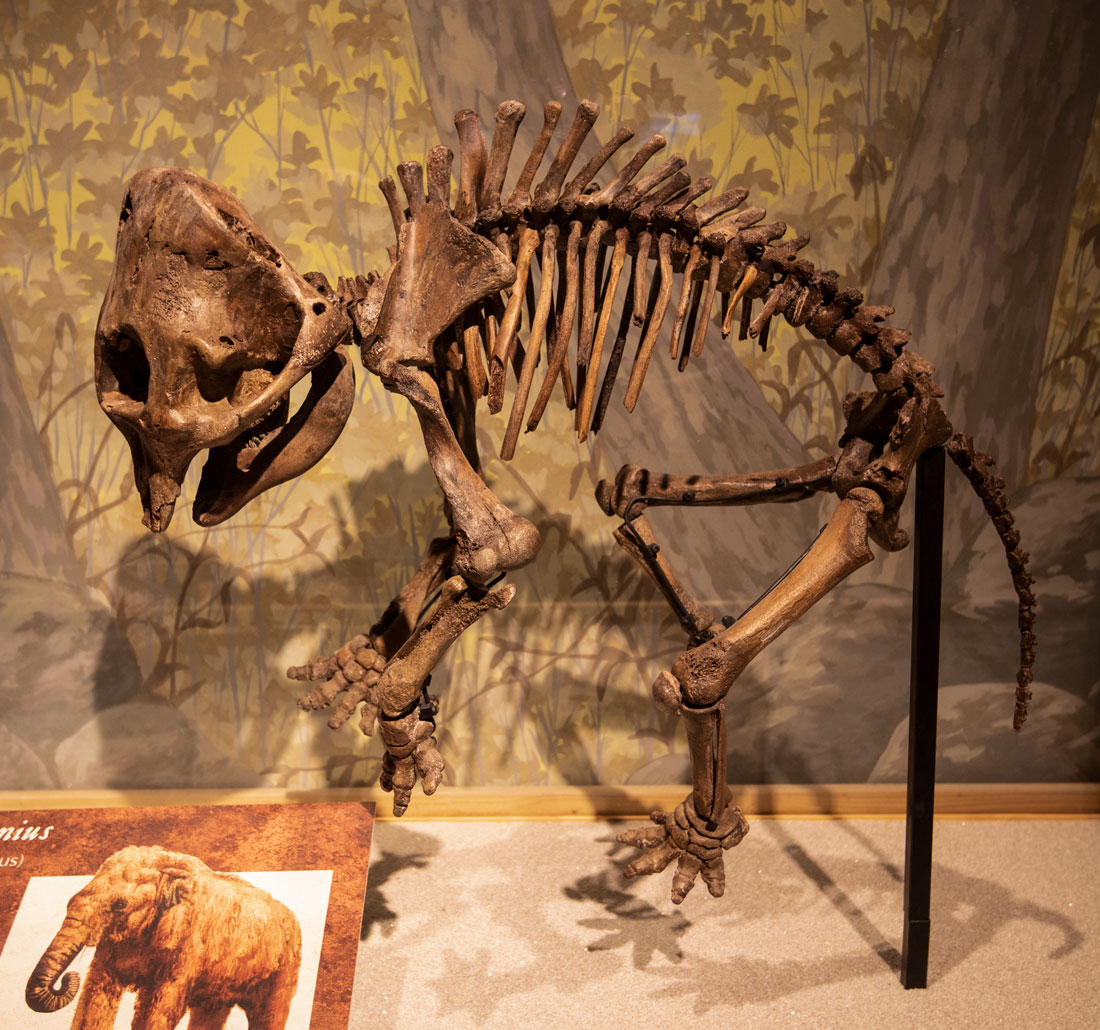
Replica of a baby mammoth skeleton found on the Yamal Peninsula.
Woolly mammoths were the final mammoth species, most dying out around the last glacial retreat when there was a mass extinction. Recent findings show that some were still living in northern Eurasia and the Americas, including Alaska, about 10,000 years ago. Slightly later, woolly mammoths also disappeared from continental northern Siberia. A small population survived on St. Paul Island, Alaska, until 3750 BC, and the small mammoths of Wrangel Island survived until about 2000 BC..
Scientists are uncertain what caused mammoth extinction. A warming trend about 12,000 years ago may have contributed as forests replaced open woodlands and grasslands in which the mammoths lived. Around the time of the extinctions, advanced human hunters spread through northern Eurasia and the Americas. Hunting could have been another major cause of extinction. The mammoths also may have succumbed to disease.
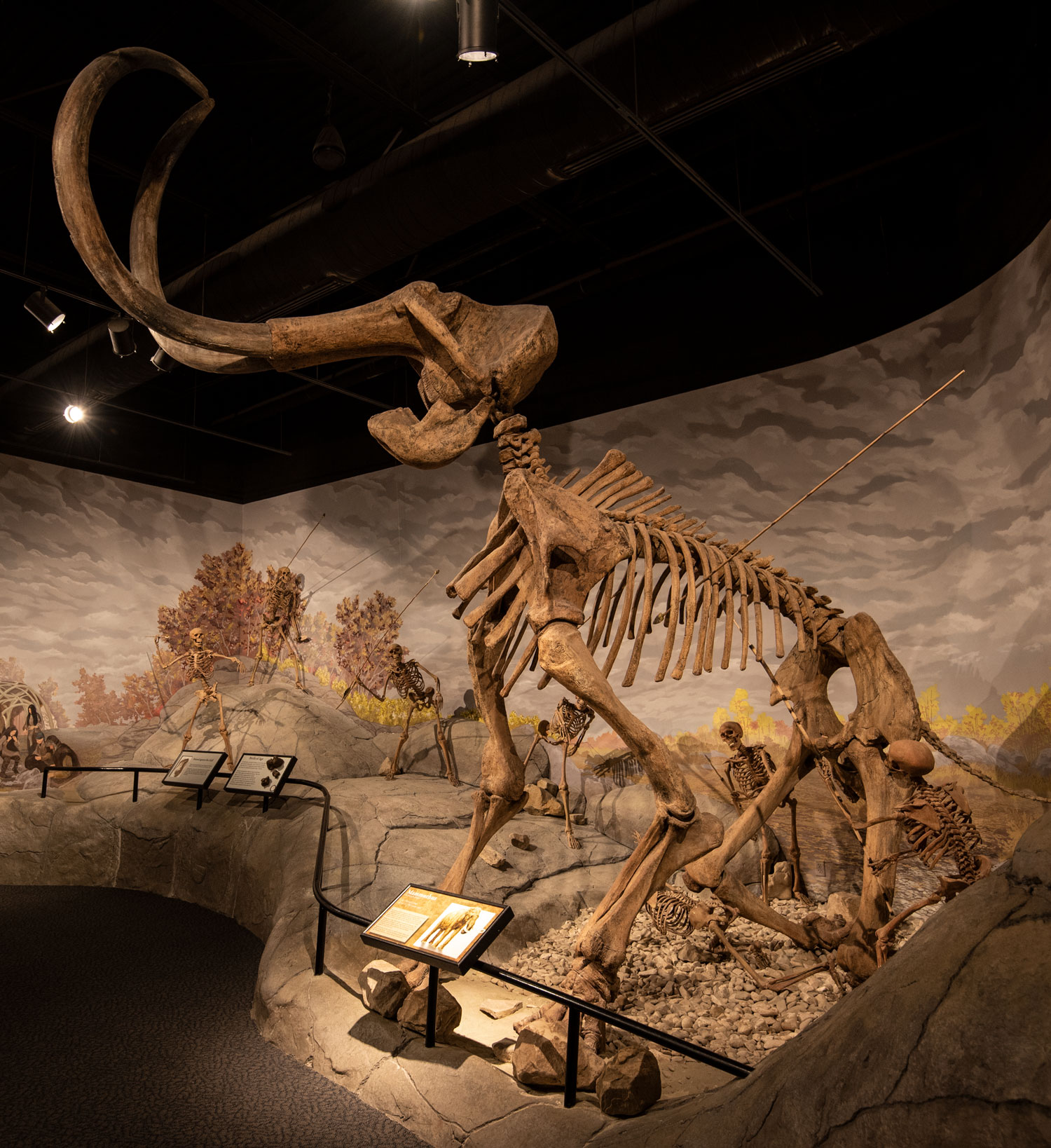
Humans are known to have consumed mammoth meat as early as 1.8 million years ago. A 50,000-year-old site in southern Great Britain produced evidence that Neanderthals butchered mammoths. Humans used mammoth bones to build dwellings in Eastern Europe 15,000-44,000 years ago. The American Institute of Biological Sciences has said that apparent butcher marks on some bones actually could have been caused by other mammoths trampling bones left on the ground.
As far as local extinctions are concerned, scientists have suggested that mammoths on Saint Paul Island in Alaska died out because sea levels rose and the island shrank by 80-90 percent.
Pygmy mammoths on the Channel Islands of California likely were killed by early Native Americans and experienced habitat loss from rising sea levels. An intact pygmy mammoth skeleton was discovered on the Channel Islands in 1994. The pygmy mammoths apparently descended from regular sized mammoths that swam six miles to the islands when the sea level was 300 feet lower than it is now. As ice sheets and glaciers melted, the sea level rose and trapped the mammoths on the islands. They gradually shrank over 20,000 years to 5-6 feet tall because of a limited food supply. They went extinct about 10,000 years ago. In 2015, a complete mammoth skull was excavated that is larger than any others discovered on the islands and could be an intermediate mammal.
In 1999, a near complete body of an adult woolly mammoth frozen 23,000 years ago in Siberia’s Talmyr Peninsula was dug out of the permafrost. It was 11 feet tall and about 40 years old when it died. It was lifted in a 23-ton block of ice by helicopter and flown to ice caves in Siberia where a sub-freezing laboratory was made. It was carefully defrosted with hair dryers over months before it was studied.
A head of a woolly mammoth with eyes, ears and body hair and part of its trunk was found in November 2003.
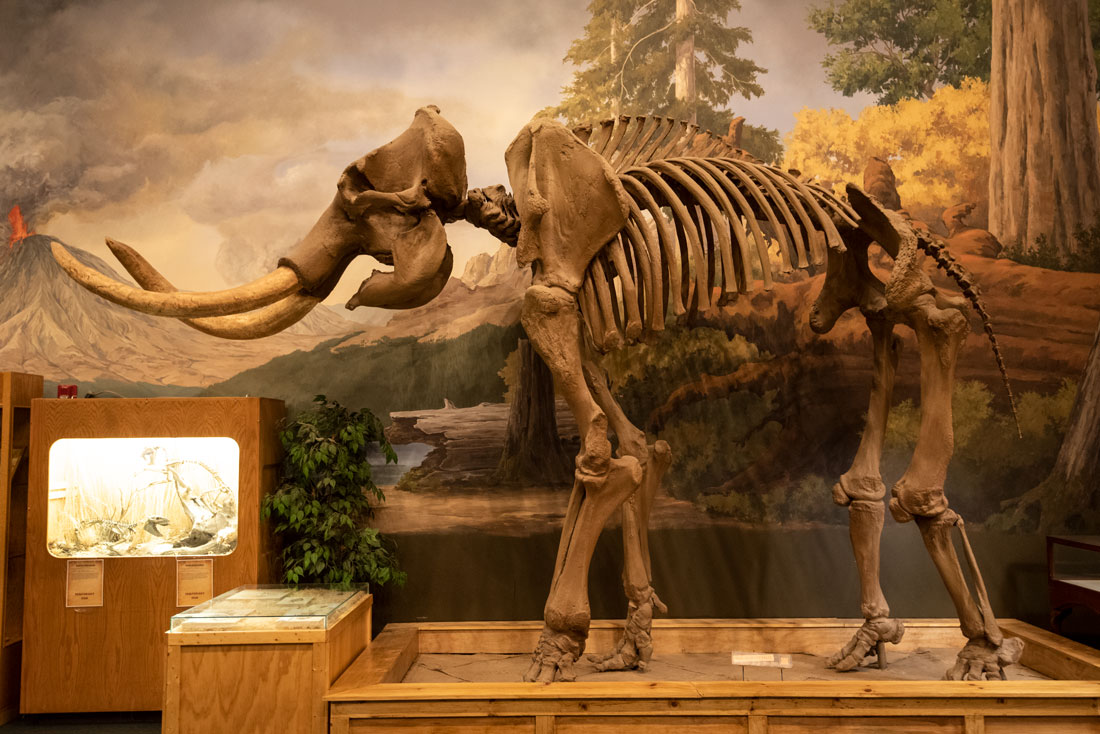
A mammoth skeleton, Eccles Dinosaur Park, Ogden, Utah.
In 2012, scientists announced that they had found the world’s smallest mammoth on Crete, an adult about the size of a newborn modern elephant. Scientists had thought that dwarf elephant fossils found on Mediterranean islands were descendants of a mainland elephant, but the teeth of the newly discovered specimen were that of a mammoth. The mammoth was half the weight of the previously known smallest dwarf mammoth.
Hunting Mammoth Tusks
As the Arctic permafrost is thawing, millions of buried mammoth skeletons have been revealed. When Ice Age glaciers spread across Siberia, these mammoths fell into icy water and were entombed in permafrost. Parts of Siberia’s frozen land now are warming twice as fast as the rest of the world. Permafrost, which remains frozen year round, has a surface layer of dirt and sediment that thaws in summer and freezes in winter. Some parts of this layer are not freezing, leaving the permafrost exposed to warmer temperatures. As it thaws, it is revealing ancient mammoth bones. Tusk hunters with amphibious vehicles, helicopters, river boats and firefighter pumps that melt the ice are racing to retrieve mammoth ivory from the permafrost to satisfy China’s voracious demand for ivory.
A single tusk can sell for $50,000 at an auction and $35,000 directly to a Chinese dealer, so tusk hunters can earn $100,000 in about a week.
Some 80 percent of harvested Siberian mammoth tusks go to China to be carved into sculptures and trinkets. Russia exported 72 tons of mammoth tusk in 2017. Since then, official exports have dropped off but the trade probably has not declined. More tusk hunters are selling illegally to Chinese dealers because the legal licensing process is mired in red tape.
Customs data indicates that about 36 tons of mammoth tusks and pieces are brought into Hong Kong annually. Of that, 29 tons of mammoth tusks are re-exported to China.
Mammoth ivory has large cracks and stains and a brown outer layer. The best tusks are restored with auto body filler and varnish and sold, while others are carved into chess sets and other small items. The lowest quality tusks are ground into powder for Chinese medicine.
The illegal trade hurts scientific efforts to study the woolly mammoth because licensed collectors often have agreements with scientific organizations to hand over skulls and bones of the creatures to the organizations for free. The collector legally owns a specimen and gets a cut of the profits when it is exhibited abroad.
Some of the specimens the hunters find are valuable, with hair and soft tissues that scientists can use for DNA analysis and study with CT scanners.
Ivory carvers and vendors started switching from using elephant ivory to mammoth ivory in 2017, when China banned the import and sale of elephant ivory to curb elephant poaching. The mammoth tusks enter Hong Kong and then are taken to the southern Chinese city of Guangzhou just two hours away. Guangzhou, ivory carving factories make carvings and jewelry from the ivory. Chinese ivory carving goes back to the 14th century. Ivory is valued as a status symbol and for its creamy white aesthetic.
An estimated 10 million mammoths are buried in Siberia, far outnumbering the 350,000 African elephants. Chinese consumers are happy to buy mammoth ivory as long as it resembles white ivory.
When mammoth tusks are traded whole, they are easy to identify because they are brown, larger than elephant tusks and twisted. To identify the origins of a piece of tusk or carved sculpture, dealers and vendors have to take a photo of the stacked chevron-like pattern visible in a cross-section. If the angle at which the lines meet is less than 90 degrees, the tusk was that of a mammoth. If it is over 90 degrees, it was that of an elephant. Even vendors find it difficult to determine which items are made from elephant ivory and which from mammoth ivory.
Check out these related items
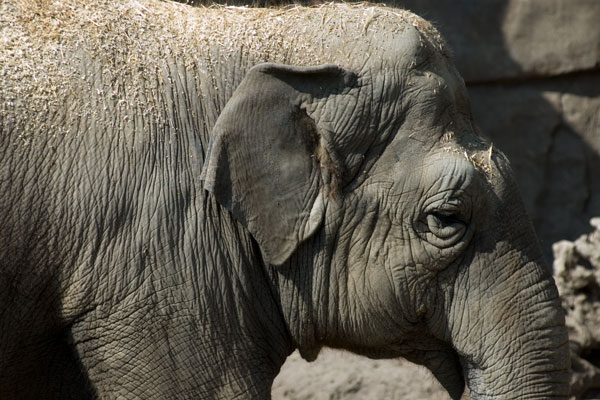
The Elephant Needs the Room
Despite tough bans on ivory trade, Africa's elephants are declining in numbers because of poaching and trafficking of illegal ivory.
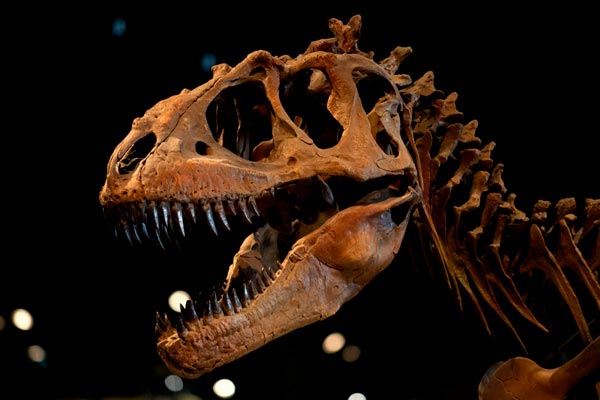
Utah’s Rock Stars
Utah's spectacular scenery harbors one of the world's most complete and diverse dinosaur fossil records.
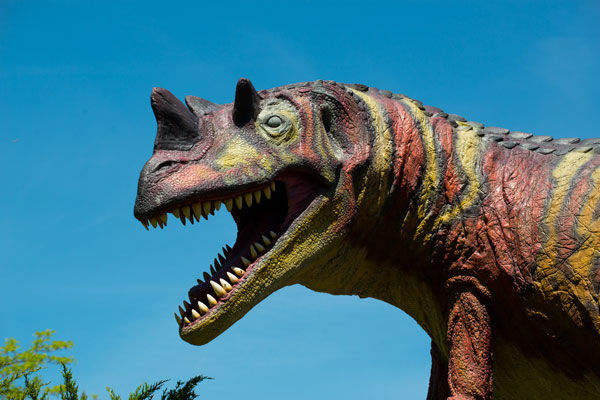
Dinosaur Gateway
To put flesh on those enormous dinosaur bones you see at museums, head for the dinosaur park in Ogden, Utah.
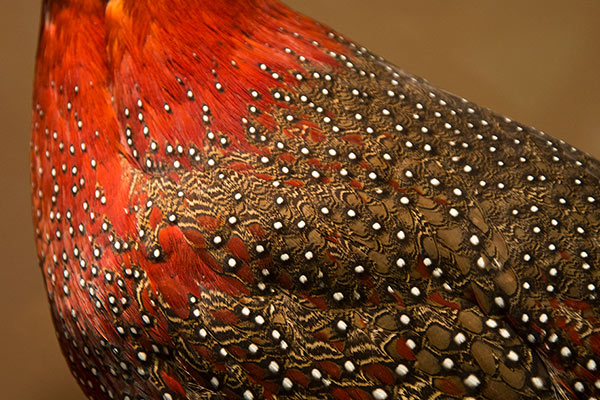
Feathers of a Bird
Of all creatures, only birds have feathers. These delicate, sophisticated, beautiful structures perfectly combine form and function.
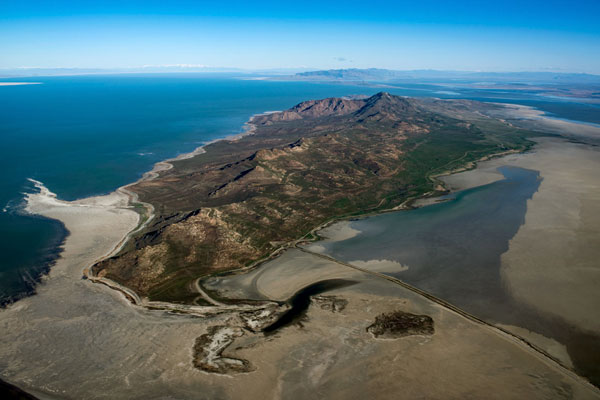
Saving the Great Salt Lake
The Great Salt Lake, along with other saline lakes worldwide, is drying out. Preserving and restoring won't come cheap.

The Day the Mountains Disappeared
Salt Lake City, Utah, was the seventh most polluted city in the world last Friday, shrouded in smoke from California wildfires.
